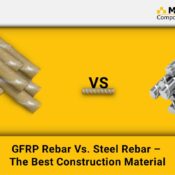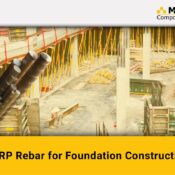How the Construction Industry in the Philippines Is Changing – And Why GFRP Rebar Is the Future
The construction industry in the Philippines is at a turning point. You can see it on every street corner — new roads, bridges, buildings, and public infrastructure popping up. The momentum is real, but so are the challenges. Between the salty coastal air, humid climate, and frequent typhoons, traditional construction materials just aren’t cutting it anymore. And that’s where GFRP Rebar is stepping in.
Let’s break this down and explain why contractors across the Philippines are starting to pay serious attention to Glass Fiber Reinforced Polymer bars — or GFRP bars, for short.
Why GFRP Rebar is Gaining Ground
GFRP Rebar - Glass Fiber Reinforced Polymer is a non-corrosive, high-strength alternative to steel. Think of it as the next generation of rebar — lighter, stronger and far more resistant to the kind of wear-and-tear that Philippine infrastructure faces every day.
GFRP Rebar Advantages
- Corrosion Resistant: GFRP bars are corrosion resistant construction material. It does not rust and corrode. It is compatible with water, salt water, and other chemicals.
- Lighter material, easier transport. GFRP is ¼ lighter than traditional steel reinforcement bars. The transportation of GFRP is easy as compare to steel rebar.
- Durable: GFRP Rebar comes with various properties such as corrosion resistant, strength, lightweight, non-conductive, etc. GFRP Rebar is durable construction material. It increases the lifespan of construction material.
Real Challenges in the Philippine Market – And How GFRP Helps
Let’s be real: construction in the Philippines isn’t easy. If you’ve worked on projects near the coast — and most of us have — you’ve probably seen steel start corroding within a couple of years. Bridges and marine structures are especially vulnerable. The truth is, we’re building in one of the most corrosion-prone environments in Asia.
That’s why many engineers are rethinking the old ways and switching to GFRP rebars. These bars don’t just survive harsh conditions — they thrive in them.
Where GFRP Is Being Used Right Now
1. Bridges and Marine Projects
Contractors use GFRP in bridge and marine projects. GFRP rebar is stronger, corrosion resistant, lighter material. It provides more strength at lightweight. It is an ideal choice for bridges and marine projects.
2. Roadworks and Flyovers
For government contractors building roads in flood zones or high-traffic areas, GFRP is quickly becoming the go-to. It’s easy to install, and it holds up better during heat waves or monsoon season.
3. High-Rise Construction
In cities like Manila, Makati, and Quezon City, developers are realizing that gfrp bars can reduce dead load — helping with foundation and column design while extending structural life.
4. Power Plants and Hospitals
GFRP is non-conductive and non-magnetic, making it perfect for areas that demand zero interference.
What Contractors Should Look For in GFRP Suppliers
If you’re planning to use GFRP rebars, don’t just go with the cheapest quote. Check:
- Bar testing and compliance with international standards
- GFRP bars price based on size and quantity
- Delivery timelines
- Project consultation and technical guidance
MRG Composite
MRG Composites Rebar is the leading GFRP rebar manufacturer in India, offering high-quality and durable solutions for construction projects. As The Pioneers of GFRP rebars in India, MRG Composites sets the benchmark for innovation and reliability. With the best GFRP rebar prices in India, we ensure quality and reliability. Contact us for expert consultation and superior reinforcement solutions. GFRP Rebar is an ideal choice for all construction.
Conclusion: Is GFRP Worth the Switch?
If you’re in construction — especially in roads, bridges, or coastal infrastructure — the answer is yes. The construction industry in the Philippines is changing. Fast. And contractors who adapt with smarter materials like glass fiber reinforced polymer bars are the ones who’ll stay ahead.
We're no longer building just for today. We’re building for tomorrow — and GFRP helps make sure what we build lasts.
FAQs
- What is GFRP and how is it used in Philippine construction?
GFRP stands for Glass Fiber Reinforced Polymer. GFRP Rebar comes with various properties such as high strength, lightweight, non-conductive, corrosion resistant, etc. Contractors and engineers use GFRP rebar in bridges, roads, highways, industrial floors, base slab, and many more.
- How does GFRP compare to steel rebar in terms of cost?
GFRP’s cost is a little high as compared to GFRP Rebar. GFRP Rebar is a durable construction material, By using GFRP Rebar construction does not require regular maintenance and replacement. GFRP Rebar saves the maintenance and construction replacement costs.
- Where can I get GFRP rebars for a project in the Philippines?
MRG Composites is a leading GFRP Rebar manufacturer and supplier. We export GFRP rebar worldwide.
- What is the HSN Code for GFRP Rebar?
The HSN Code of GFRP Rebar is 701990
All Categories
Recent Posts
GFRP Rebar vs. Steel Rebar: Strength, Durability & Benefits
GFRP Rebar for Foundation Construction
MON-SAT 8:00-9:00
+91 69 863 6420




